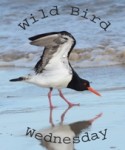We are “reverse snowbirds,” permanent Florida residents who follow the birds north to our Illinois condo in the spring. We reverse the process and return to catch up with them in the fall as they stream back across Florida. This spring was particularly unproductive near our home in interior southeast Florida, as strong easterly wind flow across the peninsula caused neotropical migrants northbound from Cuba to follow the west coast or fly directly across the Gulf of Mexico. However, when we arrived in Illinois in early May, we were greeted with cold and rainy weather for the first two weeks of our stay, and again were disappointed at a poor turnout of warblers. By the end of the month, the weather turned sunny, windy and hotter than back home in Florida.
The vagaries of Chicagoland weather reminded me that just the opposite happened late last May, nearly at the end our stay in Illinois, when I was pretty much side-lined. The weather had taken a nasty turn, with cold rain and light frost two mornings the previous week. On top of that I came down with a nasty sinus infection that turned into bronchitis and wheezes. Waiting for the antibiotics and inhalers to kick in gave me time to reflect upon a recent good birding experience.
I can credit Mary Lou for finding the best bird of last spring’s Illinois visit, her 506th North American life bird. We were walking in the Aurora West Forest Preserve in Kane County, when we heard some loud cackling and squawking noises that persisted for about 10 seconds. They seemed to be from a bird, but were like nothing I had ever heard before. The nearest I could imagine would be a chicken-like species, but did not think that bobwhites or pheasants ever made sounds like that. Then, she spied a fairly large bird low in a tree right next to the trail. As it was partially hidden among the leaves, I almost dismissed it as a thrasher or a grackle. It flew a few yards to another tree and we noted its white undersides, plain brown back, and drooping tail. It lacked rufous in its wings, which are characteristic of the more common Yellow-billed Cuckoo.
Then it softly called “ku-ku-ku…ku-ku-ku…” and I recognized its call as that of a Black-billed Cuckoo:
In addition to its all-black bill, it also had small under-tail spots and a red ring around its eye:
We also encountered a Swainson’s Thrush, with is drab brown back and tail and prominent eye-ring:
I felt well enough to celebrate International Migratory Bird Day the next weekend by helping staff the Kane County Audubon Society booth at the Bird Fest. In anticipation of leading a bird walk, Mary Lou and I scouted out the planned route, located at Peck Farm Park in Geneva, Illinois. On a sunny and warm morning, two days before the Fest, we found lots of birds, some of which were seen up close and personal– just the kind of views that we hoped would enthrall the anticipated (mostly young) participants.
As we entered the path for the bird walk, we saw that Tree Swallows had occupied one half of a double-sided bluebird house:
The second member of the Tree Swallow pair stood guard in a small tree next to the nest:
For my forthcoming walk, I planned to provide my interpretation of the reason why the bluebird houses were placed back-to-back. Tree Swallows aggressively defend their nesting territory against all other bird species, but especially other Tree Swallows. It has been shown that pairing of bluebird houses, either back-to-back or only a few feet apart, and then leaving a space of some 100 yards before erecting another pair of boxes, may provide bluebirds a better chance at nesting in one of the paired boxes.
It seems that the Tree Swallows are more tolerant of other species if they are able to successfully defend their territories against other Tree Swallows, and perhaps the two species assist each other in this defense. House Sparrows can disturb this plan, as they claim the boxes earlier in the spring, and usually are able to evict bluebirds. The sparrows should generally be removed if they begin to colonize the bird houses, as they can eventually displace all other species.
Indeed, the other half of the bird house had already been taken over by House Sparrows. The male was perched nearby:
The kids love robins and they were singing all around the trails. I decided it would be fun if I asked them to close their eyes and try to identify all the sounds around them:
I hoped the kids would be astonished by the sound and beauty of an Eastern Meadowlark:
Red-winged Blackbirds are so easy to identify by sight and sound, were also abundant:
American Goldfinches were numerous:

An Indigo Bunting sang from the lower branches of a tree next to the lake:
Among the Little Brown Birds (LBBs) were a Song Sparrow…
…and a partially hidden Savannah Sparrow, all readily distinguishable to a beginner by voice, if not appearance:
We heard the “CHE-BEK” calls of three Least Flycatchers:
On the way back, we identified the “FITZ-BYEW” calls of two Willow Flycatchers in the small willows along a creek (the red barn is out of focus behind the bird):
A territorial Common Yellowthroat, singing one of the endless varieties of its “WICHITY-WICHITY-WICHITY” song peered up at us from beneath a shrub that we were sure would soon be a nesting site:
We had seen 32 bird species in the course of an hour, and I looked forward to the Bird Fest, only two days away. Unfortunately, a strong cold front rolled in the next day, and temperatures dropped from near 80 degrees into the 40s that afternoon. It rained during the night, and in the morning we set up our booth on the porch of the Peck Farm Park interpretive center, fighting high winds from the north and a wind chill in the low 30s that kept the crowds away. I led the 10:30 AM bird walk for five hardy participants. One was a little girl who wore a flimsy fleece jacket but who participated enthusiastically. After 15 minutes the others gave up, yet she and her father kept with me as we tallied a paltry count of 13 species over a half hour. By then I was miserable with chills and fever, but her spirit was heartwarming!
Shared in BIRDING IS FUN, June 3, 2012
View prior ROSYFINCH RAMBLINGS posts



























